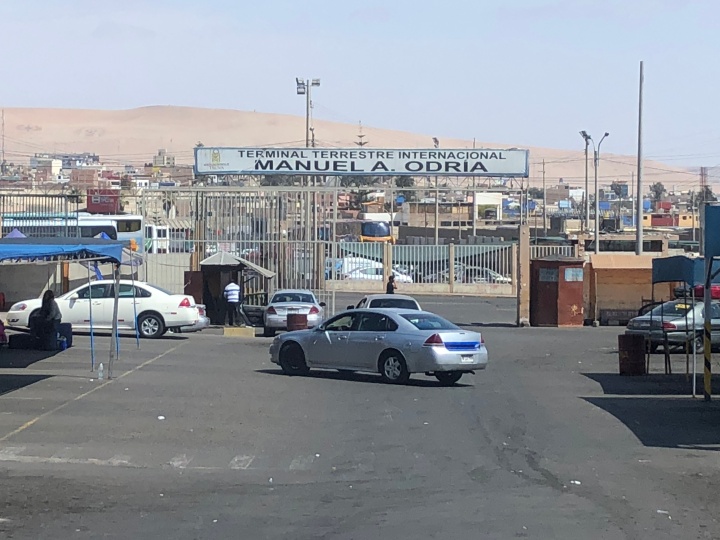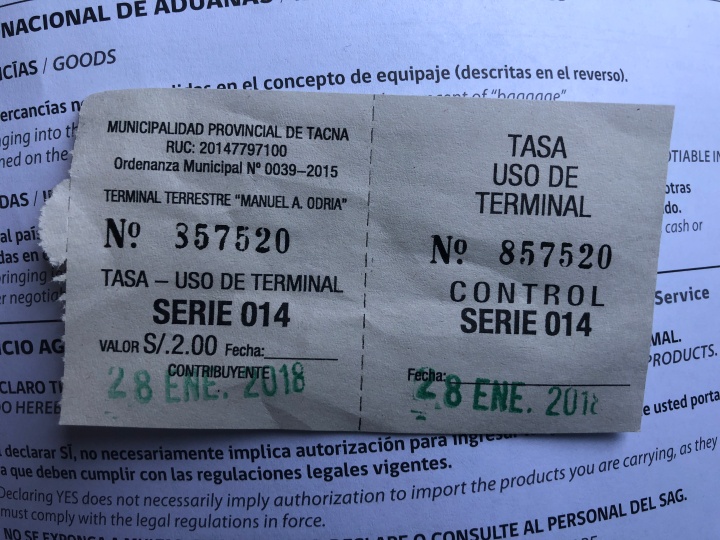We’ll start this one off with a disclaimer: crossing the border between Peru and Chile was not something we were looking forward to. We had read conflicting information on travel blogs, and our Spanish is limited to basic words and phrases, leaving us ill-equipped to deal with any potential drama. In the end, though, we made it without any major issues!
Step 1: Get to Tacna
We started our journey in Arequipa, Peru, a six-hour bus ride from Tacna, Peru’s southernmost city. A stop in Tacna is mandatory for anyone wanting to cross the border into Chile. We knew the process could take most of the day, so we boarded a Flores bus in Arequipa at 7:30 a.m. (As far as we could tell, only two companies – Flores and Cromotex – provide service from Arequipa to Tacna.) The bus was only partially full and the ride to Tacna was smooth, sans a few winding parts and an objectionable bathroom – but we’ll spare you the details on the latter.
Step 2: Exchange money and pay your bus tax
Once we arrived in Tacna at the Flores bus station – it was next door to the domestic/national terminal, where most buses arrive – we lugged our bags across the dusty street to the international bus terminal. We knew we needed to exchange some money (we wanted Peruvian soles as well as Chilean pesos, just to be safe), pay our bus tax, and then board a bus or colectivo to cross the border. It was easy enough to exchange our money, but it took a bit of wandering around the station to locate the Ticket de Embarque booth. We paid 2 Peruvian soles ($.60) each and were given paper stubs.


Step 3: Board a bus
Next, we headed to a corner of the station to get in line beneath a sign that read Embarque Buses Arica-Chile. We tried to go up to the many counters that apparently sold tickets to Arica, but we were assured that we could just pay on the bus. We read that taking a colectivo was also an option for crossing the border, but we chose the bus because it was cheaper and that’s what everyone else was doing. The buses leave when they are full – about every 10 minutes.

When we got to the front of the line, the man standing outside the bus asked for our passports and a piece of paper we were supposedly given when we entered Peru. However, we flew into Cusco and had no such paper. There were a few moments of confusion until a second man came up and explained that we had flown into Peru. Satisfied with that explanation, the first man took our passports, handed us an immigration form, and motioned for us to load our bags into the bottom of the bus and then board. It was nerve-wracking being separated from our passports, but the man was holding everyone else’s IDs, and was counting them over and over again, presumably to do a headcount, so we tried to relax.
While on the bus, we filled out our immigration form. A few minutes into the ride, a woman walked through the bus to tear our stubs, and the man collected our ticket money – 12 soles (less than $4) each. We only had a bill of 50 soles, but he came back with our change.
It took about a half hour for our bus to reach the Chacalluta border complex.

Step 4: Cross the border
When we arrived at the border, buses went to the left, and cars and colectivos went to the right. We were grateful we had taken the bus because the area on the right looked like a parking lot. Our bus inched forward slowly for at least 45 minutes. We could see that everyone in the buses before us had to off-board on the Peruvian side, stand in line, walk across the border and then re-board on the Chilean side.
When it was finally our turn, the man signaled for us to get off the bus, grab our bags from beneath the bus, and then follow him to the area where we’d get in line. At that time, he returned everyone’s IDs and passports. We appeared to be the only foreigners aside from two other Colombians.
We stood in line with our bags and passports, and then got stamps at neighboring windows: one to leave Peru and one to enter Chile. Then, we looped around into a building where we handed off our immigration forms and put our bags through a security scanner. From there, we walked across the border, rejoined our bus group, loaded our bags onto the bus and re-boarded. This part took about a half hour.
Once back on the bus, it took about 25 minutes to reach Arica’s terminal terrestre (“bus station”).
Step 5: Move onward from Arica
Based on the blogs we read, we assumed we would have no problem getting overnight bus tickets to San Pedro de Atacama, our next destination. However, when we arrived at the Arica bus station, it was swarming with people, presumably because it was a Sunday night during the summer season. We started with Turbus, then visited nearly every single window before quickly realizing that we would not get a ticket to San Pedro de Atacama for more than 24 hours. We then tried to get tickets to Calama, the hub closest to San Pedro de Atacama, but everyone was sold out. (Sadly, we walked up to one window only to learn that the people ahead of us got the last two tickets!)
At this point, it was approaching 7 p.m. due to the lengthy border crossing and time change. (Chile is 2 hours ahead of Peru.) We admitted defeat and exited the station in search of a hostel for the evening.
We can’t say for sure if it would have been as difficult to reach other destinations like Antofogasta, Copiapó or Santiago – but our advice is to always have a backup plan in case you need to stay the night. We didn’t have one, so we spent nearly an hour lugging our bags around unfamiliar Arica in search of a hostel or hotel. Some were closed and others were reservation-only. Eventually, we found a place to sleep – and lived to tell the tale!
Stay cool and calm, and you’ll make it just fine, too.


